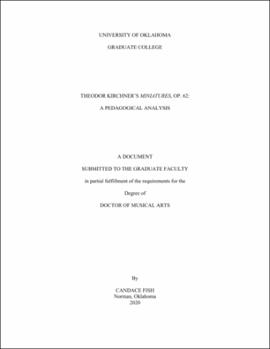| dc.description.abstract | This study provides a pedagogical and performance analysis of the Miniatures, Op. 62 of Theodor Kirchner. Kirchner was a 19th century composer, pianist, organist, and conductor who was incredibly prolific and yet remains little-known to many pianists today. Kirchner had close relationships with many reputable composers, such as Brahms, Mendelssohn, Wagner, Robert Schumann, and Clara Schumann. His musical output consists mostly of piano miniatures, which total at 73 collections of pieces. He also wrote over 70 transcriptions of symphonic and instrumental works for piano solo and piano ensemble, several pieces for chamber ensemble, vocal lieder, and various other compositions.
This study is organized into five chapters. The first chapter provides an overview of the study, including the purpose of the study, need for the study, organization, and related literature. A biographical sketch of Theodor Kirchner’s life follows in Chapter 2, giving brief historical context for the composer’s work. Chapter 3 provides an overview of Kirchner’s piano works, including the solo piano, the piano duet and two-piano literature, chamber music, and lieder for solo voice. In Chapter 4, the author provides an analysis for teaching and performance for each of the 15 pieces in Miniatures, Op. 62 of Kirchner. This chapter accounts for the bulk of the study. These analyses detail information regarding technique, articulation, pedaling, fingering, and form.
The fifth chapter synthesizes the analyses from Chapter 4 and contributes a summary of Miniatures, Op. 62 and its key attributes. This summary includes an assessment of the accessibility of certain pieces in the collection and a brief discussion of the influence of Schumann. In Chapter 5 the author also recommends additional collections of music and sources for further study into Theodor Kirchner. Because many of these materials are in German, the author identifies the need for more research into Kirchner’s life and the translation of sources into English. Included at the end of the study are a bibliography and three useful appendices: 1) a complete list of works by Theodor Kirchner, 2) a summary of the key features in Miniatures, Op. 62, and 3) a suggested order of study for the Miniatures, Op. 62. | en_US |
